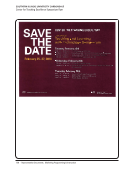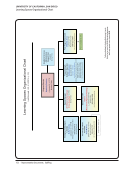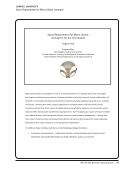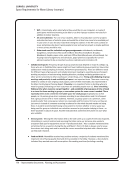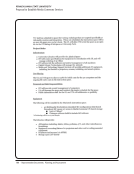SPEC Kit 342: Next-Gen Learning Spaces · 85
To give students (and faculty) the tools to be collaborative and creative. Increasing interdisciplinary and inter-
professional collaborations, and testing and evaluating new technologies. Increasing instructional collaboration with
academic faculty in our space.
To improve student success in the university and after
To model the behavior of the scholar in the digital age. Be an active partner in the creation of knowledge as opposed to
simply information finding.
To offer new learning opportunities for students, opportunities that they would not otherwise easily locate.
User focused, flexible with moveable furniture and technology, informal environment, mobile flat screens.
We are seeing the need to create spaces that allow for thought provoking discussions between faculty and students
that are informal, something of a ‘touchdown’ space after or between classes where questions and discussion flow
freely. Configuring or reconfiguring spaces within the building for specific needs of students such as individual and
group study areas, open informal work areas, computer learning, quiet study, etc. Students are asking for a variety of
spaces and furniture options, allowing for them to customize and “own” spaces within the library. These spaces also
need to maximize flexibility to accommodate various functions, needs, and group sizes. Spaces need to be comfortable,
make it easy to collaborate, flexible for a variety of learning environments, and they need to be inspiring. Research,
learning, programming, etc., doesn’t happen or doesn’t need to happen in one specific space within the library. A space
that establishes facilities that enable users to incorporate media segments into assignments, e-portfolios, and research
projects. Creating a “Labrary” space idea where spaces in the library can be devoted to testing out new furniture and
layout of furniture or testing software. One that provides spaces that accommodate new patterns of learning, i.e.,
SCALE-UP classrooms.
We envision the role of next-gen learning spaces as active and collaborative spaces.
We hear from faculty that they greatly appreciate the commitment of our library system to create classrooms and
teaching spaces that support new pedagogical methods. They can schedule a class in our spaces and explore techniques
with high levels of support, and then return to their home departments to campaign for improvements in their own
buildings. Several departments have copied our decisions—buying the same models of video cameras, document
cameras, short-throw projectors, etc.—after first exploring these gadgets in our spaces. We also hear from faculty who
are the early adopters of new technology that they enjoy coming to explore what we have in our next-gen spaces so
they know what is on the horizon for their own disciplines.
We intend to create more collaborative spaces to support the growing trend of interdisciplinarity. The spaces will take
into account the new pedagogical methods largely based on collaborative work. The staff already play a key role in
helping students with new technologies, new tools, and new platforms and this role will continue to grow in the future.
We envision facilitating access to learning spaces by broadening access to the facilities outside normal operating hours.
We need more integration of our IT group, more sandbox or incubation spaces for technology. However, with that
should come a teaching and learning component this isn’t just to open up a space with gadgets and tools without some
kind of instructional or programming component.
We think that 80% or more of learning happens in non- or co-curricular space. We are following our users (faculty
and students), listening to their needs, and continually evolving. Next-gen spaces will grow in importance for the
foreseeable future.
To give students (and faculty) the tools to be collaborative and creative. Increasing interdisciplinary and inter-
professional collaborations, and testing and evaluating new technologies. Increasing instructional collaboration with
academic faculty in our space.
To improve student success in the university and after
To model the behavior of the scholar in the digital age. Be an active partner in the creation of knowledge as opposed to
simply information finding.
To offer new learning opportunities for students, opportunities that they would not otherwise easily locate.
User focused, flexible with moveable furniture and technology, informal environment, mobile flat screens.
We are seeing the need to create spaces that allow for thought provoking discussions between faculty and students
that are informal, something of a ‘touchdown’ space after or between classes where questions and discussion flow
freely. Configuring or reconfiguring spaces within the building for specific needs of students such as individual and
group study areas, open informal work areas, computer learning, quiet study, etc. Students are asking for a variety of
spaces and furniture options, allowing for them to customize and “own” spaces within the library. These spaces also
need to maximize flexibility to accommodate various functions, needs, and group sizes. Spaces need to be comfortable,
make it easy to collaborate, flexible for a variety of learning environments, and they need to be inspiring. Research,
learning, programming, etc., doesn’t happen or doesn’t need to happen in one specific space within the library. A space
that establishes facilities that enable users to incorporate media segments into assignments, e-portfolios, and research
projects. Creating a “Labrary” space idea where spaces in the library can be devoted to testing out new furniture and
layout of furniture or testing software. One that provides spaces that accommodate new patterns of learning, i.e.,
SCALE-UP classrooms.
We envision the role of next-gen learning spaces as active and collaborative spaces.
We hear from faculty that they greatly appreciate the commitment of our library system to create classrooms and
teaching spaces that support new pedagogical methods. They can schedule a class in our spaces and explore techniques
with high levels of support, and then return to their home departments to campaign for improvements in their own
buildings. Several departments have copied our decisions—buying the same models of video cameras, document
cameras, short-throw projectors, etc.—after first exploring these gadgets in our spaces. We also hear from faculty who
are the early adopters of new technology that they enjoy coming to explore what we have in our next-gen spaces so
they know what is on the horizon for their own disciplines.
We intend to create more collaborative spaces to support the growing trend of interdisciplinarity. The spaces will take
into account the new pedagogical methods largely based on collaborative work. The staff already play a key role in
helping students with new technologies, new tools, and new platforms and this role will continue to grow in the future.
We envision facilitating access to learning spaces by broadening access to the facilities outside normal operating hours.
We need more integration of our IT group, more sandbox or incubation spaces for technology. However, with that
should come a teaching and learning component this isn’t just to open up a space with gadgets and tools without some
kind of instructional or programming component.
We think that 80% or more of learning happens in non- or co-curricular space. We are following our users (faculty
and students), listening to their needs, and continually evolving. Next-gen spaces will grow in importance for the
foreseeable future.










































































































































